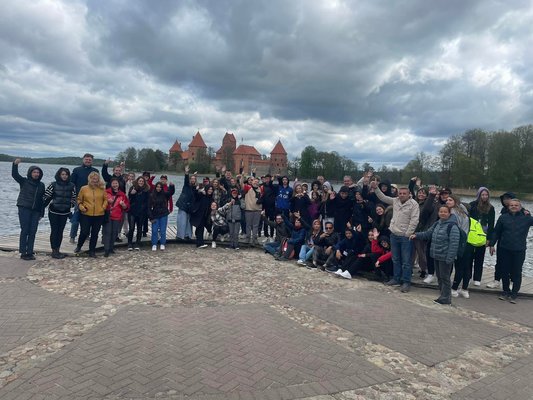The Mobility in Poland
The first day of the short-term exchange of groups of pupils we all spent at school. The guests were invited in a Polish traditional way, with bread and salt, by the headmistress Mrs. Dorota Dorozińska and the main coordinator of the project Mrs. Mariola Podolska-Maculewicz. They were also introduced to the Polish wedding dances and songs prepared and performed by the youngest pupils of the school community. They also saw other kind of dance shown by two cheerleader groups. To get to know each partner country better there was conducted a guessing game on the topic of partner countries connected with national symbols and other important information. The pupils from each partner schools also presented important aspects of their countries, cities and schools. In the afternoon we visited the Town Hall and had a meeting with the major of Nidzica Mr. Jacek Kosmala who familiarized the international project members with our town, region and answered questions about some aspects of the Polish educational system. At the end of a busy afternoon the logo of the project was chosen. It was not an easy task as there were many interesting ones to choose from. The winning logo was designed by a Turkish pupil. To symbolize the beginning of our common journey through the world of folklore all the participants planted the Erasmus+ ”Folklorica” tree being the very good starting point of our cooperation. The day ended with a lot of fun. The pupils of all countries were taught the regional dance called ”Szot”. The pupils from the partner countries appeared to be quick learners and really good dancers. At homes of the Polish hosts the pupils had the chance to get to know traditional customs meanwhile the teachers during the staff meeting discussed the most important aspects of the project. The second day of the visit started early in the morning and was full of interesting activities. It was the day to get to know and admire a lot of Polish culture and cultural Heritage. We did a lot of sightseeing in Warsaw, the Capital City of Poland. We were shown the Royal Castle and the National Museum by guides. We also took part in the workshop on making delicious Polish chocolate. Tired but satisfied with knowing so much Polish national heritage we came back home late in the evening. Olsztynek, Olsztyn. The next day of the visit stepped us back in time, too. We started it with visiting a small Glass Factory where we could find out how artistic handmade glass is produced in a traditional way and admired the artistry of work of the workers. In the Open Air Ethnographic Museum in Olsztynek pupils were supposed to find some objects such as an old windmill or a small chapel there, take photos which would be used to prepare a poster on the topic of that place. We also took part in two workshops. One was on painting on glass regional motives and the other one was on decorating tiles the way it used to be done in the past. Learning by doing was the aim of all the activities planned for that day. The afternoon we spent in Olsztyn, the capital city of Warmia and Masuria. On the way home everyone could admire the beauty of the region full of lakes and forests and feel and see Polish golden autumn and try traditional Polish cuisine served near the lake. This day we spent in Toruń which, because of nice weather, invited us not only for a walk through the streets of the beautiful Old Town full of Polish national heritage but for interesting workshops as well. All had a lot of fun making gingerbread according to old recipes in the Museum of Gingerbread. In the Factory of Candles And Soap we also spent nice time making and decorating candles and soap the way each of us liked. Creativity was welcome. The day ended with a fascinating activity. All liked Polish legends seen in the House of Legends performed by ”people from the past”. The last day of the visit started with taking part in lessons conducted at school which was a good way to compare the educational systems of partner countries. Another activity at school was the creative workshop for students who could develop their artistic skills working with folk motives. For the teachers it was the time to sum up the exchange, evaluate it and plan the work ahead. The day was also designed as the culinary day so we went to a Pottery Village called Kamionka - first to prepare some pots of clay and then to make lunch which consisted of the typical dishes of the region such as ”kopytka” and dumplings served with vegetable salad. After lunch, prepared by pupils, which was really delicious, we came back to Nidzica to take a closer look at Nidzica 13th century Teutonic castle and listen to the most important facts concerning it (guided by a graduated pupil of the host school). After that visit there was some free time to spend time with host families and get ready for the last meeting, the farewell dinner. After the oficial part, during which certificates for the participants were distributed, all of us had fun dancing traditional dances and listening to traditional music played by ”Berklejdy”, the folk band. At the end pupils exchanged their mail addresses and with eyes full of tears came back home to spend the late evening together. The Polish folk adventure has come to an end. We are looking forward to the next one. This time in Romania.
Mariola Podolska-Maculewicz, project coordinator, Szkoła Podstawowa Nr 2 z Oddziałami integracyjnymi im. Michała Kajki w Nidzicy, Poland
The Mobility in Poland.pptx
Mobilność w Polsce
Pierwszy dzień krótkoterminowej wymiany grup uczniów wszyscy spędziliśmy w szkole. Goście zostali przywitani w tradycyjny polski sposób, chlebem i solą, przez dyrektorkę, panią Dorotę Dorozińską i główną koordynatorkę projektu, Panią Mariolę Podolską-Maculewicz. Zapoznano ich także z polskimi tańcami weselnymi i pieśniami przygotowanymi i wykonanymi przez najmłodszych uczniów społeczności szkolnej. Uczestnicy widzieli także inny rodzaj tańca pokazany przez dwie grupy cheerleaderek. Aby lepiej poznać każdy kraj partnerski, przeprowadzono grę w zgadywanie na temat krajów partnerskich związaną z symbolami narodowymi i innymi ważnymi informacjami. Uczniowie ze szkół partnerskich przedstawili także ważne aspekty swoich krajów, miast i szkół. Po południu odwiedziliśmy Ratusz i spotkaliśmy się z burmistrzem Nidzicy Jackiem Kosmalą, który zapoznał członków międzynarodowego projektu z naszym miastem i regionem i odpowiedział na pytania dotyczące niektórych aspektów polskiego systemu edukacji. Pod koniec pracowitego popołudnia wybrano logo projektu. Nie było to łatwe zadanie, ponieważ było wiele ciekawych do wyboru. Zwycięskie logo zostało zaprojektowane przez tureckiego ucznia. Jako symbol początku naszej wspólnej podróży przez świat folkloru, wszyscy uczestnicy posadzili drzewo „Folklorica” Erasmus +, które jest bardzo dobrym punktem wyjścia naszej współpracy. Dzień zakończył się dobrą zabawą. Uczniowie wszystkich krajów uczyli się tańca regionalnego o nazwie „Szot”. Uczniowie z krajów partnerskich okazali się być szybkimi uczniami i naprawdę dobrymi tancerzami. W domach polskich gospodarzy uczniowie mieli okazję poznać tradycyjne zwyczaje, i potrawy, a nauczyciele podczas spotkania koordynatorów omawiali najważniejsze aspekty projektu. Drugi dzień wizyty rozpoczął się wcześnie rano i był pełen ciekawych zajęć. To był dzień na poznanie i podziwianie polskiej kultury i dziedzictwa kulturowego. Zwiedziliśmy wiele miejsc w Warszawie, stolicy Polski. Przewodnicy pokazali nam Zamek Królewski i Muzeum Narodowe. Wzięliśmy również udział w warsztatach na temat przygotowania pysznej polskiej czekolady. Zmęczeni, ale zadowoleni ze znajomości polskiego dziedzictwa narodowego, wróciliśmy do domu późnym wieczorem. Następny dzień wizyty również cofnął nas w czasie. Zaczęliśmy od wizyty w małej fabryce szkła, gdzie mogliśmy dowiedzieć się, w jaki sposób ręcznie wytwarzane jest artystyczne szkło artystyczne i podziwiać kunszt pracy robotników. W Muzeum Etnograficznym w Olsztynku uczniowie mieli za zadanie znaleźć takie obiekty, jak stary wiatrak czy mała kaplica, zrobić zdjęcia, które posłużyłyby do przygotowania plakatu na ten temat. Wzięliśmy również udział w dwóch warsztatach. Jeden polegał na malowaniu na szkle regionalnych motywów, a drugi na dekorowaniu kafelków, tak jak robiono to kiedyś. Uczenie się przez działanie było celem wszystkich działań zaplanowanych na ten dzień. Popołudnie spędziliśmy w Olsztynie, stolicy Warmii i Mazur. W drodze do domu każdy mógł podziwiać piękno regionu pełnego jezior i lasów, poczuć i zobaczyć polską złotą jesień oraz spróbować tradycyjnej polskiej kuchni serwowanej nad jeziorem. Czwarty dzień spędziliśmy w Toruniu, który ze względu na piękną pogodę zaprosił nas nie tylko na spacer ulicami pięknego Starego Miasta pełnego polskiego dziedzictwa narodowego, ale także na ciekawe warsztaty. Wszyscy bawili się robieniem pierników według starych przepisów w Muzeum Piernika. W Fabryce Świec i Mydła spędziliśmy również miło czas na robieniu i dekorowaniu świec i mydła według własnego pomysłu. Uczestnicy wykazali się dużą kreatywnością. Dzień zakończył się fascynującą aktywnością. Wszystkim podobały się polskie legendy w Domu Legend Toruńskich w wykonaniu ludzi z przeszłości”. Ostatni dzień wizyty rozpoczął się od wzięcia udziału w lekcjach prowadzonych w szkole, co było dobrym sposobem na porównanie systemów edukacyjnych krajów partnerskich. Kolejnym działaniem w szkole były warsztaty kreatywne dla uczniów, którzy mogli rozwijać swoje umiejętności artystyczne pracując z motywami ludowymi. Dla nauczycieli nadszedł czas podsumowania wymiany, oceny i zaplanowania dalszej pracy. Dzień został również zaprojektowany jako dzień kulinarny, więc poszliśmy do Wioski Ceramiki Kamionka - najpierw przygotowaliśmy garnki z gliny, a następnie zrobiliśmy lunch składający się z typowych potraw regionu, takich jak kopytka i pierogi podawane z warzywami Sałatka. Po lunchu, przygotowanym przez uczniów, który był naprawdę pyszny, wróciliśmy do Nidzicy, aby przyjrzeć się bliżej zamkowi krzyżackiemu z XIII wieku w Nidzicy i posłuchać najważniejszych faktów na jego temat (prowadzonych przez absolwenta szkoły przyjmującej). Po tej wizycie uczestnicy mieli czas wolny, aby spędzić go z rodzinami goszczącymi i przygotować się na ostatnie spotkanie - kolację pożegnalną. Po części oficjalnej, podczas której rozdano wszystkim uczestnikom spotkania certyfikaty, wszyscy bawiliśmy się tańcząc tradycyjne tańce i słuchając tradycyjnej muzyki granej przez zespół folklorystyczny „Berklejdy”. Na koniec uczniowie wymienili adresy pocztowe i z oczami pełnymi łez wrócili do domu, aby spędzić razem późny wieczór. Polska przygoda ludowa dobiegła końca. Nie możemy się doczekać następnego spotkania. Tym razem w Rumunii.
Iwona Nasiadka, nauczyciel, Szkoła Podstawowa nr 2 z Oddziałami Integracyjnymi im. Michała Kajki w Nidzicy, Poland
The Mobility in Romania
To describe the mobility in Romania I posted two presentations: a video, with English texts, made by the coordinator from Turkey, Umut Uysaler, and a PowerPoint one, with texts in Romanian, made by the coordinator from Romania, Gabriela Mirela Jugar. The video presentation was posted here after uploading it to Youtube. The PowerPoint will also be used to disseminate the mobility in Romania within the Teacher Pedagogical Council on December 17, 2019, where the coordinator from Romania will promote the project ”Folklorica”. The local media and the Sibiu County School Inspectorate were with the project team for the whole period of this mobility. We owe the success of this mobility to the parents of our pupils who have supported us in its preparation and development.
Mircea Dorca, teacher in ”Constantin Noica” High School Sibiu
Mobilitatea din România
Pentru descrierea mobilității din Romînia am postat două prezentări: una video, cu texte în engleză, realizată de coordonatorul din Turcia, Umut Uysaler, și una PowerPoint, cu texte în română, făcută de coordonatoarea din România, Gabriela Mirela Jugar. Prezentarea video a fost postată aici după încărcarea ei pe Youtube. Cea în PowerPoint va fi folosită și pentru diseminarea mobilității din România în cadrul Cercului Pedagogic al Învățătorilor din 17 decembrie 2019, unde, coordonatoarea din România va promova proiectul ”Folklorica”. Mass media locală și Inspectoratul Școlar Județean Sibiu au fost alături de echipa de proiect pe toată durata acestei mobilități. Succesul acestei mobilități îl datorăm și părinților elevilor noștri care ne-au sprijinit în pregătirea și derularea ei.
Raluca Teglaș, profesor al Liceului Teoretic ”Constantin Noica” Sibiu
Mobilitatea din România.pptx
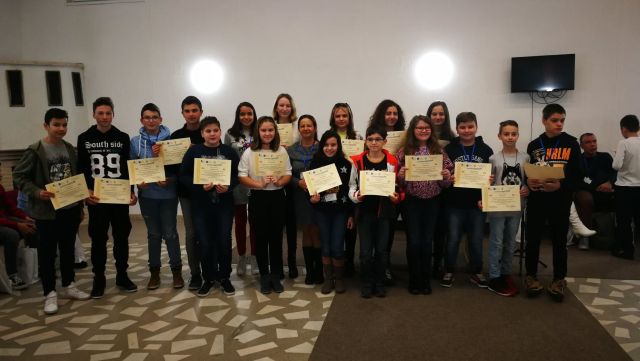
https://www.facebook.com/erkan.demirci.5074/videos/2692046967522148/
(movie on the project Facebook Group added by Erkan Demirci, Turkey)
The Mobility in Turkey
According to the established program of this Erasmus+ project of strategic school partnership 2019-2021, on the 17th of October 2021, Umut Uysaler, the host coordinator, welcomed the partners from Lithuania and Poland and accommodated them in the hotel and families. On 18th October, Folklorica team began with welcoming ceremony prepared by students led by Aydın Acar. After the artistic show, teachers and pupils met in the assembly room where we had the chance to see the presentations of pupils on the traditional child games in their countries. After the meeting in the assembly room, all the team started trying “Ebru”, in other words “art of writing on water” traditional Turkish handcraft. First, Fatma Karadoğan, art teacher made a demonstration then, let the guests try. Our guests did well on the art itself and created excellent works of art. When we finished the workshop on “Ebru”, we gathered as coordinators in headmaster’s room. Here, coordinators had time to talk about the general functioning of the project, and discussed the things to be done in the near future. Apart from discussing some details of the project, coordinators exchanged opinions on the education systems of partner countries. Turkish headmaster made a briefing on Turkish education system, then we discussed about similarities and differences. The next step for the first day was “Ecological Building”. That building belongs to Gaziantep Metropolitan Municipality. We had a workshop there both teachers and students. Folklorica team prepared terrariums and had a great time during the activity. On 19th October, the team gathered at school and then was taken by the bus to the baklava factory. We witnessed production steps of the worldly famous baklava and learned how to it baklava. That was strange and funny to see the team trying. Second day of the mobility was reserved for the cultural trips. First, the team visited “Zeugma Mosaic Museum” which is the largest mosaic museum of the world. We spent around an hour there and passed to “War Museum”. There, Folklorica team saw the wax statues. They were telling us the way to independence during the War of Independence. Last stop was “Toy Museum”. Especially, students had great time there. It is an old and traditional Gaziantep house, which was renewed and turned to museum where we saw old toys, made of wood mostly. On 20th October, The Folklorica team was in Kids Art Center where we had another workshop. We tried mosaics this time. Students learned and tried making and painting mosaics. After all, there were many brilliant artifacts. When we finished in Art center, there was Parkantep on the way. That was planned totally for students. Under the surveillance of their teachers, pupils spent nice time trying all attractions in the park. On 21st October, we had another feast of culture. We visited Mount Nemrut which is on list of Unesco World Heritage List. With a diameter of 145 m, the 50 m high funerary mound of stone chips is surrounded on three sides by terraces to the east, west and north directions. Two separate antique processional routes radiate from the east and west terraces. Five giant seated limestone statues, identified by their inscriptions as deities, face outwards from the tumulus on the upper level of the east and west terraces. These are flanked by a pair of guardian animal statues – a lion and eagle – at each end. After the visit to the mount, we passed to city center, had lunch there and then set out for Cendere Bridge, which is accepted as one of the oldest bridges in the world. When we finished in the city, next stop was Halfeti, a town that is famous due to a dam project. Much of Halfeti was submerged under water due to the Birecik Dam, which flooded the area in the 1990s and so a new town was subsequently built about 15 kilometers away. As such, the settlement is divided into New and Old Halfeti. The remnants of Old Halfeti, sunken into the river, have attracted visitors who marvel at the sight that could be compared to an underwater museum. Folklorica team had a boat tour on Euphrates and the ruins of old town. Finally, we ended the day with a nice dinner near the shore of Euphrates and come back to Gaziantep. The last day in Gaziantep, we visited the zoo after breakfast. It is the biggest in Turkey and the fourth biggest in the world. Zoo is located in a large area and many animals are possible to see. After the visit to zoo, guests were given time to go for shopping and to pack for departures. We met at school in the afternoon for certificate ceremony and exchanging symbolical gifts, and the last day finished with farewell dinner. 23rd October, Saturday, everything that has a beginning must have an end. We spent a nice and fruitful week together as a team. We were so happy to host you all. We are looking forward to meet again very quickly in Spain.
Umut Uysaler, coordinator, Vali M. Lütfullah Bilgin Ortaokulu, Turkey
Türkiye'de Hareketlilik
Erasmus+ Stratejik Okul Ortaklığı 2019-2021 projesinin belirlenen programına göre 17 Ekim 2021 tarihinde ev sahibi koordinatör Umut Uysaler, Litvanya ve Polonya'dan gelen ortakları havaalanında karşılayarak, kalacakları otel ve ailelere yönlendirdi. Folklorica hareketliliği, 18 Ekim'de Aydın Acar başkanlığındaki öğrenciler tarafından hazırlanan karşılama töreniyle başladı. Sanatsal gösterinin ardından öğretmenler ve öğrenciler toplantı salonunda bir araya gelerek, öğrencilerin ülkelerindeki geleneksel çocuk oyunlarıyla ilgili sunumlarını görme fırsatı buldu. Toplantı salonundaki toplantının ardından tüm ekip, geleneksel Türk el sanatlarından olan ”Ebru“ yani ”su üzerine yazma sanatı" nı denemeye başladı. Önce resim öğretmeni Fatma Karadoğan bir gösteri yaptı, sonra misafirler denemeye başladılar. Misafirlerimiz Ebru ile ilgili iyi iş çıkardılar ve mükemmel sanat eserleri yarattılar. “Ebru" konulu çalıştayı bitirdiğimizde; koordinatörler müdür odasında toplandık. Burada koordinatörlerin projenin genel işleyişi hakkında konuşmak için zamanları oldu ve yakın gelecekte yapılması gerekenleri tartıştılar. Koordinatörler projenin bazı detaylarını tartışmanın yanı sıra ortak ülkelerin eğitim sistemleri hakkında görüş alışverişinde bulundular. Türk okul müdürü Türk eğitim sistemi hakkında bir brifing verdi, ardından benzerlikler ve farklılıklar hakkında konuşuldu. İlk gün için bir sonraki adım “Ekolojik Bina” idi. O bina Gaziantep Büyükşehir Belediyesi'ne ait. Orada hem öğretmenler hem de öğrenciler için bir atölye çalışması yaptık. Folklorica ekibi teraryumlar hazırladı ve etkinlik sırasında harika zaman geçirdi. 19 Ekim'de okulda toplanan ekip daha sonra otobüsle baklava fabrikasına götürüldü. Dünyaca ünlü baklavanın üretim aşamalarına tanık olduk ve baklavanın nasıl yapıldığını öğrendik. Takımın baklava yapışını izlemek ilginç ve komikti. Hareketliliğin ikinci günü kültür gezilerine ayrıldı. Ekip ilk olarak dünyanın en büyük mozaik müzesi olan “Zeugma Mozaik Müzesi”ni ziyaret etti. Orada yaklaşık bir saat geçirdik ve “Savaş Müzesi” ne geçtik. Orada Folklorica ekibi balmumu heykellerini gördü. Kurtuluş Savaşı sırasında bize bağımsızlığın yolunu anlatıyorlardı. Son durak "Oyuncak Müzesi" idi. Özellikle, öğrenciler orada harika zaman geçirdiler. Yenilenen ve eski oyuncakları gördüğümüz bu ev, müzeye dönüştürülen, çoğunlukla ahşaptan yapılmış eski ve geleneksel bir Gaziantep eviydi. 20 Ekim'de Folklorica ekibi bir atölye daha gerçekleştirdiğimiz Çocuk Sanat Merkezi'ndeydi. Bu sefer mozaikleri denedik. Öğrenciler mozaik yapmayı ve boyamayı öğrendi ve denedi. Sonuçta, birçok harika eser ortaya çıktı. Sanat Merkezi'ndeki programı bitirdiğimizde yolda Parkantep vardı. Bu tamamen öğrenciler için planlanmıştı. Öğretmenlerinin gözetimi altında, öğrenciler parktaki tüm cazibe merkezlerini deneyip güzel zaman geçirdiler. 21 Ekim'de bir kültür şöleni daha yaşadık. Unesco Dünya Mirası Listesi'nde yer alan Nemrut Dağı'nı ziyaret ettik. Nemrut Dağı ziyaretinden sonra şehir merkezine geçtik, orada öğle yemeği yedik ve dünyanın en eski köprülerinden biri olarak kabul edilen Cendere Köprüsü'ne doğru yola çıktık. Şehirde işimiz bittiğinde bir sonraki durak Halfeti, bir baraj projesi ile meşhur bir kasabaydı. 1990'lı yıllarda bölgeyi sular altında bırakan Birecik Barajı nedeniyle Halfeti'nin büyük bir kısmı su altında kalmış ve böylece yaklaşık 15 kilometre uzaklıkta yeni bir kasaba inşa edilmiştir. Bu nedenle yerleşim Yeni ve Eski Halfeti olarak ikiye ayrılmıştır. Eski Halfeti’deki kalıntılar, sualtı Müzesi misafirlerimizin oldukça ilgisini çekti. Folklorica ekibi Fırat ve eski kent kalıntıları üzerinde tekne turu yaptı. Sonunda günü Fırat kıyısına yakın güzel bir yemekle bitirdik ve Gaziantep'e geri döndük. Gaziantep'te son gün kahvaltıdan sonra hayvanat bahçesini gezdik. Türkiye'nin en büyüğü ve dünyanın dördüncü en büyüğüdür. Hayvanat bahçesi geniş bir alanda yer almaktadır ve birçok hayvanı görmek mümkündür. Hayvanat Bahçesi ziyareti sonrasında, konuklar alışveriş ve eve dönüş için hazırlanmak üzere otele geri döndüler. Öğleden sonra okulda sertifika töreni ve sembolik hediyelerin takdimi için buluştuk ve son gün veda yemeğiyle sona erdi. 23 Ekim Cumartesi, başlangıcı olan her şeyin bir sonu olmalı. Ekip olarak birlikte güzel ve verimli bir hafta geçirdik. Hepinizi ağırlamaktan çok mutluyduk. İspanya'da en kısa sürede tekrar buluşmayı dört gözle bekliyoruz.
Hulusi Gürbüz, okul müdürü Vali M. Lütfullah Bilgin Ortaokulu, Turkey
Dragobete vs. Valentine’s Day
The pupils of the “Constantin Noica” High School Sibiu, Romania prepared a PowerPoint material to present to the partners from the Erasmus+ project “Folklorica” within the mobility in the Canary Islands, Spain. The theme was a parallel between “Dragobete”, a Romanian traditional holiday and the famous “Valentine’s Day”. The material exposes the traditions and ends with the urge to draw flowers with all partners in the name of love on earth and friendship between the partners of this European project.
Gabriela Mirela Jugar, coordinator ”Constantin Noica” High School Sibiu
Dragobete vs. Valentine's Day.pptx
Dragobete vs. Ziua Îndrăgostiților
Elevii Liceului “Constantin Noica” Sibiu, România, au pregătit un material PowerPoint pe care să îl prezinte partenerilor din proiectul Erasmus+ “Folklorica” în cadrul mobilității din Insulele Canare, Spania. Tema a fost o paralelă între Dragobete, o sărbătoare tradițională românească și celebra “Ziua Îndrăgostiților”. Materialul expune tradițiile și se încheie cu îndemnul de a desena flori cu toți partenerii în numele iubirii pe pământ și al prieteniei între partenerii acestui proiect european.
Georgeta Sava, director adjunct, L. T. ”C-tin. Noica”, Sibiu

The Mobility in Gran Canaria, Spain
The first day of the short-term exchange of groups of pupils in Gran Canaria started with a warm welcome at school. All the guests were kindly greeted by the Spanish team and the school authorities. After the welcome speeches of the Spanish coordinator and the headmaster of IES Peres Galdós, it was the time for presentations on the topic of carnivals and Valentine’s Day in partner countries prepared and presented by each participating group. While having a trip around the school all the guests were impressed by the decorations of the school connected with celebration of Valentine’s Day as well as the rehearsal of the play showing the origin and evolution of this festival.
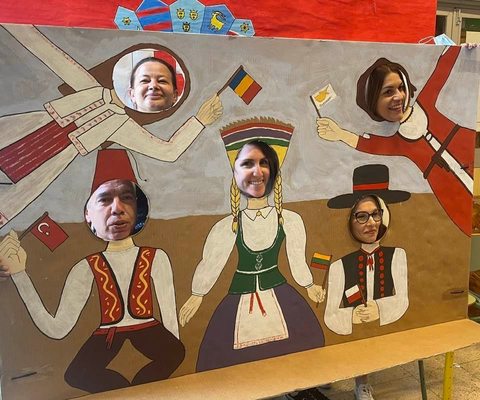
The participants of the meeting were also shown the classrooms and took, due to COVID-19 restrictions, a very short part in lessons of different subjects. After the walk around the school while pupils were enjoying themselves in the school playground getting integrated with one another the teachers were having staff meeting. The educational system of Gran Canaria was introduced and compared to others especially in the pandemic time. At noon we set off for Vegueta tour, the Old Town of Las Palmas. Besides, some of the most important and interesting places like connected with history and cultural heritage were shown by the tour guide. We had the opportunity to admire the beauty of the balconies.
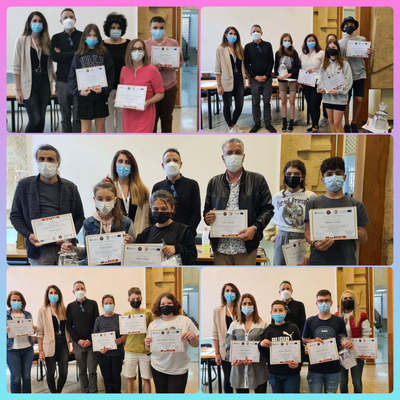
We got to know information about the new modern Town Hall which replaced the old one burnt before. To admire the breathtaking view of the ocean and the whole city we reached the top of the old cathedral very important to the citizens. After the trip the pupils went back with host families to their houses to spend the evening together. Some of them spent it actively playing volleyball on the beach by the Atlantic Ocean. The second day of the historical and cultural adventure started with the trip to Tejeda - a village considered as one of the most beautiful villages in Spain in an outstanding mountain area which is on the UNESCO list of cultural heritage of the world. Walking along the village, filled with plenty of folk architecture, we have headed for Medicinal Plants Museum which corresponds to one of the topics of the project.
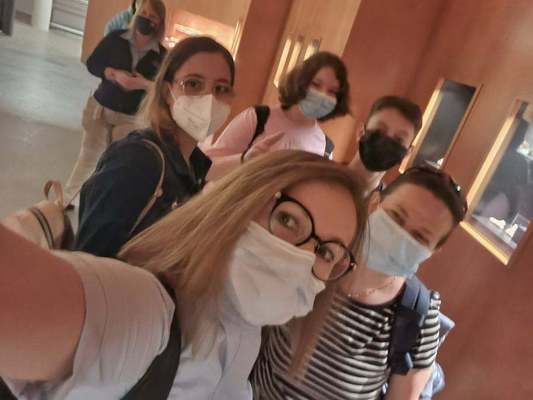
To appreciate the benefits of our mother nature the participants were served tasty tea of dried herbs grown in the area, commonly used to cure different diseases. The view from the mountain presenting the ocean and another island is something we will always remember. After returning to Las Palmas pupils spent time with peers and host families getting to know Canarian cuisine and preparing some typical meals together. It was a tasty experience. spent time with peers and host families getting to know Canarian cuisine and preparing some typical meals together. It was a tasty experience. On the 3rd day of the visit we were woken up by the beautiful sun. We were very happy with such weather as it was supposed to be a bit more relaxing day than the previous ones, spent sightseeing and admiring the landscape and all beauty of the island. All participants started with the departure for southern part of the island. Our first stop was Mogán, well known for having one of the best climates in Europe. On the way to our destination we were marveling over the beautiful flora and the landscapes with the ocean in the background which differ a lot from those we have in our partner countries. The first stop of the tour was Mogán, Maspalomas with the beach and a harbor where, on the rocks, crabs were enjoying the sun and so were we (unfortunately only for a short time). After a short brunch break, we headed to Faro de Maspalomas, Playa del Ingles.
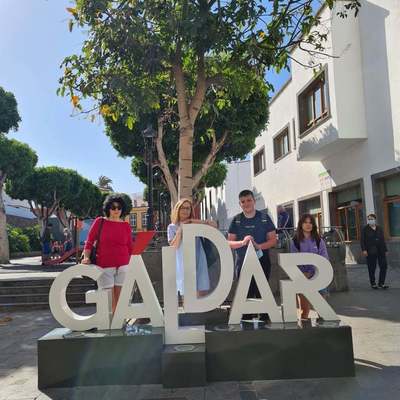
The walk towards the lighthouse which is a distinctive landmark in the resort, and is the tallest masonry lighthouse in the Canaries at 56 m was worth the effort. We also visited la Charca, a pond between the dunes and the sea where migratory birds rest in their trip between Europe and Africa. Finally, we visited Las Dunas de Maspalomas, sand dunes protected as a nature reserve since 1987. They were formed by sand from the now subdued marine shelf, when it was laid dry during the last ice age and the wind blew the sand towards the coast of the island. The afternoon and evening international pupils spent on playing and having fun on the Las Canteras beach. It was a lovely day. For the 4th day of the visit we left for the northern part of the island. We first stopped in Gáldar Town, which is an area that formed one of the two kingdoms in which the island was split during the aboriginal times. Here, we visited the Cueva Pintada museum. The pupils and teachers got to know everything that the museum has to offer: from a broad introduction to the history of the island to the visualization of the archeological place where aboriginals used to live around Gáldar. And then we were able to see for a short time the Painted Cave, which is considered as the “Sistine chapel” of the former inhabitants of the island. We had also a walk along the streets sightseeing the Old Town and once again we had the opportunity to marvel over the architecture and cultural heritage of the area. After that, we travelled to Arucas, a town really close to Las Palmas de Gran Canaria city, where we visited the Iglesia Matriz de San Juan Bautista, an impressive church of neo-gothic style which is also one of the symbols of Gran Canaria. The next stop was to visit the old town of Arucas, as well as the rum factory, where we were able to get to know how Arehucas rum is made, as well as learn the relevance of the sugar cane in the past for the economy of Gran Canaria and Canary Islands. We returned to Las Palmas de Gran Canaria in order to have some time to get ready for the dinner with some typical Canarian menu and a picnic in a park joined with playing basketball this time. And now the last day of our folk adventure on Gran Canaria came. We were waiting for so impatiently. The final day the pupils and their teachers spent the farewell day at the high school. The first hour we spent learning both teachers and pupils the “Berlina” dance, is a typical folklore dancing from La Palma Island. Then, in order to continue the fun with dances, our Turkish friends taught us their traditional dance. We all joined and had more fun together. Then, while teachers had their final staff meeting, the pupils were able to participate in a Carnival workshop organized by VET students of the high school in order to commemorate the famous Carnival of Las Palmas de Gran Canaria, which has been postponed to June due to Covid-19 pandemic. That activity was so enjoyable for all international participants and the results were surprising. Once pupils finished working on their carnival masks, we moved on to visit the Aula-Museo Pérez Galdós, which is a small museum in the high school itself created five years ago and which host different objects and show different aspects of the evolution of Education in Las Palmas de Gran Canaria City and in the host school ever since its opening in the 70s. For brunch, the pupils and their teachers enjoyed some typical Spanish breakfast meal: churros con chocolate. The last part common for all the members of the short-term exchange of groups of pupils was the farewell certification time. For all the participating members of ‘Folklorica’ project it was a pretty nice adventure hopefully not the last one in Las Palmas.
Mariola Podolska-Maculewicz, project coordinator, Szkoła Podstawowa Nr 2 z Oddziałami integracyjnymi im. Michała Kajki w Nidzicy, Poland
Mobilitatea în Gran Canaria, Spania
Prima zi a schimbului pe termen scurt de grupuri de elevi din Gran Canaria a început cu o primire călduroasă la școală. Toți oaspeții au fost întâmpinați cu amabilitate de echipa spaniolă și de autoritățile școlii. După discursurile de bun venit ale coordonatorului spaniol și ale directorului IES Peres Galdós, a venit timpul pentru prezentări pe tema carnavalului și Ziua Îndrăgostiților în țările partenere, pregătite și prezentate de fiecare grup participant. În timpul unei excursii în jurul școlii, toți oaspeții au fost impresionați de decorațiunile școlii legate de sărbătorirea Zilei Îndrăgostiților, precum și de repetiția piesei care arată originea și evoluția acestui festival. Participanților la întâlnire li s-a arătat și sălile de clasă și au luat, din cauza restricțiilor COVID-19, o parte foarte scurtă la lecții de diferite materii. După plimbarea prin școală, în timp ce elevii se distrau pe terenul de joacă al școlii, integrându-se unii cu alții, profesorii aveau o întâlnire cu personalul. Sistemul educațional din Gran Canaria a fost introdus și comparat cu altele mai ales în perioada pandemiei. La amiază plecăm spre turul Vegueta, orașul vechi din Las Palmas.
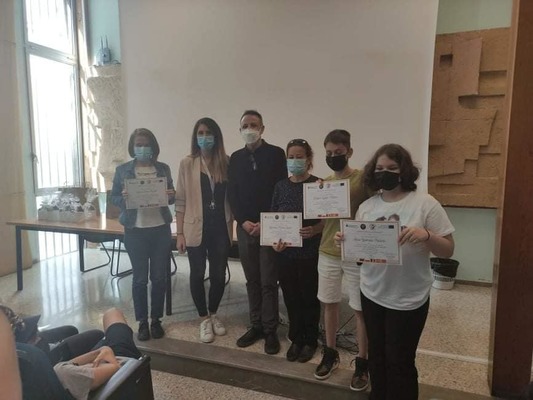
În plus, câteva dintre cele mai importante și interesante locuri, cum ar fi cele legate de istoria și moștenirea culturală, au fost prezentate de ghidul turistic. Am avut ocazia să admirăm frumusețea balcoanelor. Am aflat informații despre noua primărie modernă care a înlocuit-o pe cea veche arsă înainte. Pentru a admira priveliștea uluitoare asupra oceanului și a întregului oraș am ajuns în vârful vechii catedrale foarte importantă pentru cetățeni. După excursie, elevii s-au întors cu familiile gazdă la casele lor pentru a petrece seara împreună. Unii dintre ei au petrecut-o activ jucând volei pe plaja de lângă Oceanul Atlantic. A doua zi a aventurii istorice și culturale a început cu excursia la Tejeda - un sat considerat unul dintre cele mai frumoase sate din Spania într-o zonă montană remarcabilă care se află pe lista UNESCO a patrimoniului cultural al lumii. Mergând de-a lungul satului, plin de multă arhitectură populară, ne-am îndreptat către Muzeul de Plante Medicinale care corespunde uneia dintre temele proiectului. Pentru a aprecia beneficiile mamei noastre natură, participanților li s-a servit un ceai gustos din ierburi uscate cultivate în zonă, folosite în mod obișnuit pentru a vindeca diferite boli. Priveliștea de la munte care prezintă oceanul și o altă insulă este ceva ce ne vom aminti mereu. După întoarcere, elevii din Las Palmas au petrecut timp cu colegii și familiile gazdă cunoașterea bucătăriei canare și pregătind împreună câteva mese tipice. A fost o experiență gustoasă. am petrecut timp cu colegii și familiile gazdă, cunoscând bucătăria canariană și pregătind împreună câteva mese tipice. A fost o experiență gustoasă.
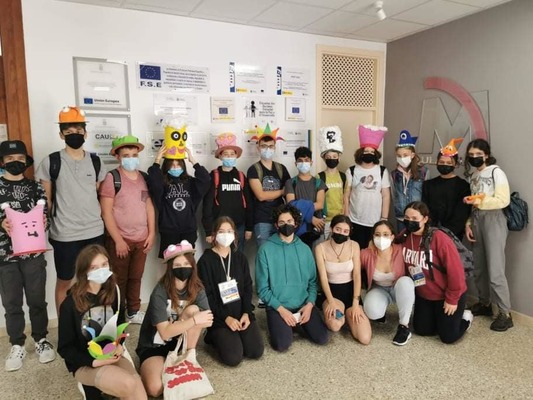
În a 3-a zi a vizitei am fost treziți de soarele frumos. Am fost foarte fericiți de o astfel de vreme, deoarece trebuia să fie o zi ceva mai relaxantă decât precedentele, am petrecut vizitarea obiectivelor turistice și admirând peisajul și toată frumusețea insulei. Toți participanții au început cu plecarea spre partea de sud a insulei. Prima noastră oprire a fost Mogán, binecunoscută pentru că are una dintre cele mai bune climate din Europa. În drum spre destinație ne minunam de flora frumoasă și de peisajele cu oceanul în fundal care diferă mult de cele pe care le avem în țările noastre partenere. Prima oprire a turului a fost Mogán, Maspalomas cu plaja si un port unde, pe stanci, crabii se bucurau de soare si noi la fel (din pacate doar pentru putin timp). După o scurtă pauză de brunch, ne-am îndreptat spre Faro de Maspalomas, Playa del Ingles. Plimbarea către far care este un reper distinctiv în stațiune și este cel mai înalt far din zidărie din Canare la 56 m a meritat efortul. Am vizitat și la Charca, un iaz între dune și mare unde păsările călătoare se odihnesc în călătoria lor între Europa și Africa. În cele din urmă, am vizitat Las Dunas de Maspalomas, dune de nisip protejate ca rezervație naturală încă din 1987. Au fost formate din nisipul de pe raftul marin acum supus, când acesta a fost așezat uscat în ultima epocă de gheață și vântul a suflat nisipul spre coastă. a insulei. După-amiaza și seara, elevii internaționali au petrecut jucându-se și distrandu-se pe plaja Las Canteras. A fost o zi minunată. Pentru a 4-a zi a vizitei am plecat spre partea de nord a insulei. Ne-am oprit mai întâi în orașul Gáldar, care este o zonă care a format unul dintre cele două regate în care insula a fost împărțită în timpurile aborigenilor. Aici am vizitat muzeul Cueva Pintada. Elevii și profesorii au cunoscut tot ce are de oferit muzeul: de la o introducere amplă în istoria insulei până la vizualizarea locului arheologic în care locuiau aborigenii în jurul Gáldar. Și apoi am putut vedea pentru scurt timp Peștera Pictată, care este considerată „Capela Sixtină” a foștilor locuitori ai insulei. Am făcut și o plimbare pe străzile care vizitează orașul vechi și am avut din nou ocazia să ne minunăm de arhitectura și moștenirea culturală a zonei. După aceea, am călătorit la Arucas, un oraș foarte aproape de orașul Las Palmas de Gran Canaria, unde am vizitat Iglesia Matriz de San Juan Bautista, o biserică impresionantă de stil neogotic care este și unul dintre simbolurile Gran Canaria.
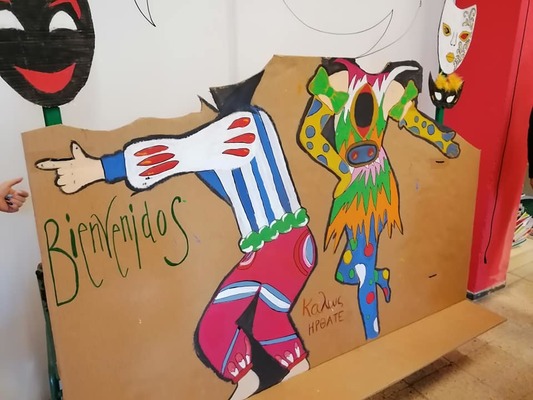
Următoarea oprire a fost să vizitam orașul vechi Arucas, precum și fabrica de rom, unde am putut cunoaște cum se face romul Arehucas, precum și relevanța trestiei de zahăr în trecut pentru economia din Gran Canaria și Insulele Canare. Ne-am întors la Las Palmas de Gran Canaria pentru a avea timp să ne pregătim de cină cu un meniu tipic canarelor și un picnic într-un parc alături de jocul de baschet de data aceasta. Și acum a venit ultima zi a aventurii noastre populare pe Gran Canaria. Așteptam cu atâta nerăbdare. În ultima zi, elevii și profesorii lor și-au petrecut ziua de rămas bun la liceu. Prima oră petrecută învățând atât profesorii cât și elevii dansul „Berlina”, este un dans popular tipic din insula La Palma. Apoi, pentru a continua distracția cu dansuri, prietenii noștri turci ne-au învățat dansul lor tradițional. Ne-am alăturat cu toții și ne-am distrat mai mult împreună. Apoi, în timp ce profesorii aveau ședința finală a personalului, elevii au putut participa la un atelier de carnaval organizat de elevii VET ai liceului pentru a comemora celebrul Carnaval din Las Palmas de Gran Canaria, care a fost amânat pentru iunie din cauza Covid19 pandemie. Această activitate a fost atât de plăcută pentru toți participanții internaționali, iar rezultatele au fost surprinzătoare.
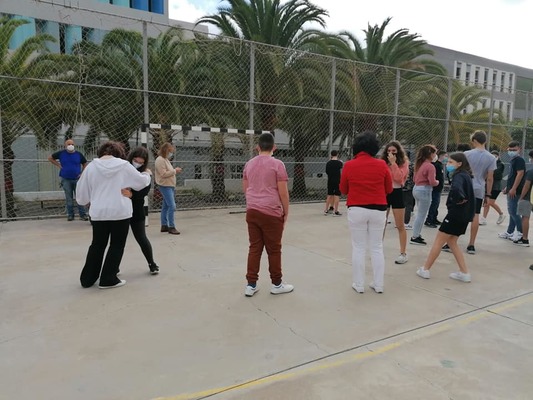
Odată ce elevii au terminat de lucrat la măștile de carnaval, am continuat să vizităm Aula-Museo Pérez Galdós, care este un mic muzeu în liceul propriu-zis creat în urmă cu cinci ani și care găzduiește diferite obiecte și prezintă diferite aspecte ale evoluției Educației în Orașul Las Palmas de Gran Canaria și în școala gazdă încă de la deschiderea ei în anii '70. Pentru brunch, elevii și profesorii lor s-au bucurat de un mic dejun tipic spaniol: churros cu ciocolată. Ultima parte comună pentru toți membrii schimbului de scurtă durată de grupuri de elevi a fost timpul de certificare de rămas bun. Pentru toți membrii participanți la proiectul „Folklorica” a fost o aventură destul de drăguță, sper să nu fie ultima din Las Palmas.
Mihai Ordean, director al Liceului Teoretic ”Constantin Noica” Sibiu
The Mobility in Cyprus
The first day of the short-term exchange of group of pupils started with a very warm welcome reception at host school Gymnasio Apostolou Pavlou in Paphos. Entering the school international project partners were greeted with Cypriot delights by traditionally dressed pupils. Shortly after we were introduced to the school and Cypriot educational system by the headmaster and school coordinator. After the speeches the time for presentations of legends and fairytales by each partner team came. Pupils did their best to interest the others. As the Turkish team couldn’t join us in Cyprus they showed their work online in the live broadcast. After exchanging symbolic gifts among us we were taken to The Home of Arts, Cypriot Crafts and Traditions).
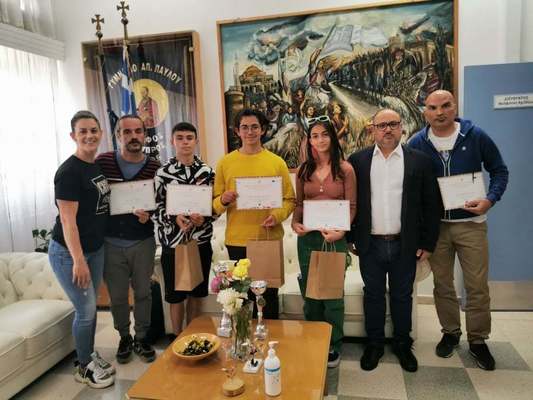
There our folk adventure continued. We took then a short tour to the warehouse where we were shown live demonstration of pottery and mosaics making which was followed by workshops for all participants who tried to become artists working on their own mosaics and pottery. After hard work tired but satisfied with the results of the workshops we visited the Town Hall where the mayor presented the history of the city, its development and plans for further improvement. Partner countries gave some information about the motherlands. After the meeting pupils with their Cypriot friends returned to school and host families while teachers during lunch at Paphos center discussed the most important project connected activities.
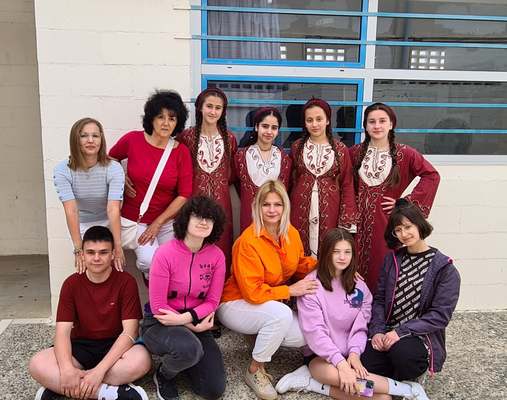
The second day of our folk adventure was supposed to be as perfect as the previous one. We started it with celebrating the birthday of the Cypriot coordinator Eleni and the Romanian pupil Amalia Elena. Visiting Lefkara during sunny weather was a pretty nice experience. After a short tour around the village in which we could admire the beauty and diversity of the Greek architecture different from the ones we are used to seeing in our countries we got to Lefkara Handicraft Center where we were presented many examples of embroidery and laces made by local women. The next stop on the way was a visit to Local Ethnological Museum of Traditional Embroidery and Silversmithing followed by another one to the church of the Holy Cross dating back to the 13th century.
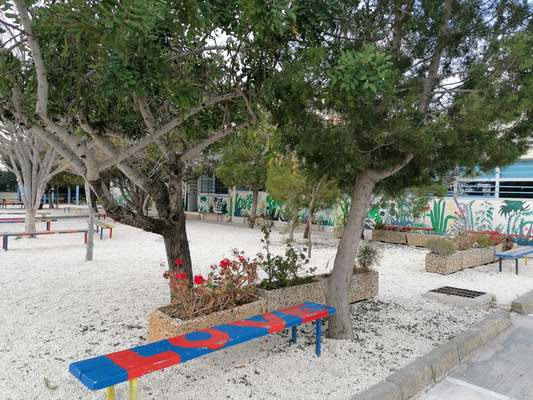
The second village planned on that day was Skarinou Village, the place where on Ktima Georgiadi and Golden Donkeys Farm we had a chance to learn how to bake traditional “koulouria” bread and homemade halloumi. Majority of the participants enjoyed the taste of both traditional products. This is also the place where olive trees are grown one of which is the oldest in Cyprus and put on UNESCO Cultural Heritage list.
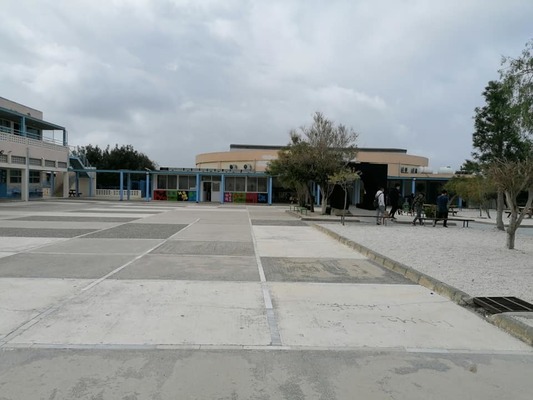
Another part of the project visit was a tour to the rural folk museum with old equipment used in the past for farm work purposes. At the end of the day we were treated with local specialties served in the farm restaurant. On the way back to Paphos we have stopped to marvel over Aphrodite’s Rock - the place where she was born. The third day started with a visit to Mosaics and Paphos Medieval Castle in Kato Paphos harbour. Firstly, we have gone together to Neo Paphos Archaeological Site being a world heritage site full of outstanding ancient Greek mosaics presenting the scenes of Greek mythology. With the help of a guide we learned a lot. In the castle situated in the harbour international participants could see the exhibition of flora and fauna pictures as well as the posters illustrating the destructive nature of a human to the ocean environment. In the past the castle was a part of a bailey and was also used as prison.
https://www.facebook.com/100002716524140/videos/pcb.1672012983147229/993763144589628
After the short trip we headed for Fyti Village where we were guided to the weaving and folkloric art museum. We have admired the exhibition of handmade pieces of clothing weaved by the owner. During the workshop of “Fytiotiko” weaving we got to know different techniques and had the chance to try to learn it. It was a very enjoyable task. The afternoon pupils together with their hosts spend the time actively cooking, having fun on the beach or exploring the city. The fourth day of our folk adventure began in Agora (the market). This time a guide showed us around the Old town and presented the history and cultural heritage of the place. Having finished the hosts took us to Geroskipou village where we visited the old factory of Aphrodite’s Delights (Loukoumia), Byzantine Church of Agia Paraskevi and The Sanctuary of Aphrodite. Leaving the pupils with their hosts and giving them time to get ready for the farewell dinner the teachers had coordinators’ meeting and worked on project tasks. The evening all the teams spent together enjoying themselves at the festive dinner. The fifth and the last day of our visit was very challenging but at the same time enjoyable. International pupils while taking part in the tie and dye t-shirts workshop could show their creativity and artistic skills. The outcomes of the workshop were awesome. The workshop was then followed by the activity we were all looking forward to from the very beginning of the meeting. The cultural group “Ieroi Kipoi” dressed up in folk costumes presented us traditional the representative Cypriot dances.
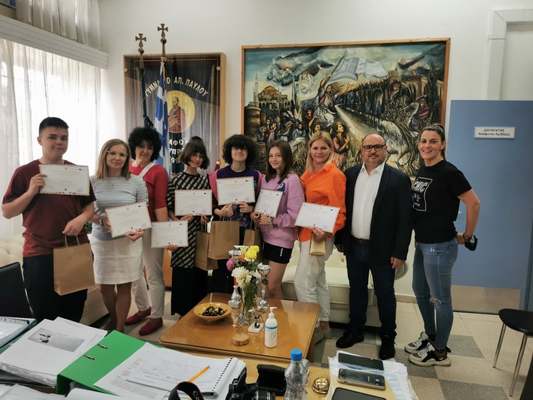
After the presentation we were eager to join the group, participate in the dance to try if we could do it as perfect as the host performers. They appeared to be as good teachers for us as we were the learners. During the short break for some coffee and brunch we were treated with delicious traditional, homemade Cypriot specialties. While the pupils were attending lessons the teachers were working hard on documents, final products and plans for the oncoming last short-term exchange in Lithuania. The last part of the day spent at school was the awarding of the attendance and activity certificates handed in by the headmaster and the host coordinator. The hosts teachers have recommend us a walk along the coast area of Kato Paphos. Late in the afternoon after shopping for souvenirs, the pupils had the opportunity to observe and admire the beautiful sunsets at the picturesque Lighthouse beach. The evening everybody spent packing and getting ready for the way back homes. It was a lovely and marvelous week spent together with our Cypriot friends.
Mariola Podolska-Maculewicz, project coordinator, Szkoła Podstawowa Nr 2 z Oddziałami integracyjnymi im. Michała Kajki w Nidzicy, Poland
Mobilitatea în Cipru
Prima zi a schimbului pe termen scurt al grupului de elevi a început cu o primire foarte călduroasă la școala gazdă Gymnasio Apostolou Pavlou din Paphos. La intrarea în școală, partenerii de proiect internațional au fost întâmpinați cu delicii cipriote de către elevi îmbrăcați în mod tradițional. La scurt timp după aceea, directorul și coordonatorul școlii ne-au prezentat școala și sistemul educațional cipriot. După discursuri a venit timpul prezentărilor de legende și basme de către fiecare echipă parteneră. Elevii au făcut tot posibilul pentru a-i impresiona pe ceilalți. Deoarece echipa turcă nu s-a putut alătura nouă în Cipru, ea și-a arătat munca online în transmisiunea în direct. După ce am făcut schimb de cadouri simbolice între noi, am fost duși la Casa Artelor, Meșteșugurilor și Tradițiilor Cipriote).
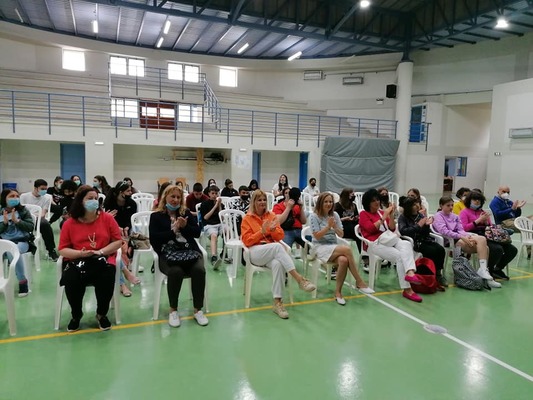
Acolo a continuat aventura noastră populară. Am făcut apoi un scurt tur la depozit, unde ni s-a prezentat o demonstrație live de realizare a ceramicii și mozaicurilor, care a fost urmată de ateliere pentru toți participanții care au încercat să devină artiști care lucrează la propriile mozaicuri și ceramică. După o muncă grea, obosiți, dar mulțumiți de rezultatele atelierelor, am vizitat Primăria unde primarul a prezentat istoria orașului, dezvoltarea acestuia și planurile de îmbunătățire ulterioară. Țările partenere au oferit câteva informații despre țările natale. După întâlnire, elevii cu prietenii lor ciprioți s-au întors la școală și apoi la familiile gazdă, în timp ce profesorii în timpul prânzului la centrul din Paphos au discutat despre cele mai importante activități legate de proiect.
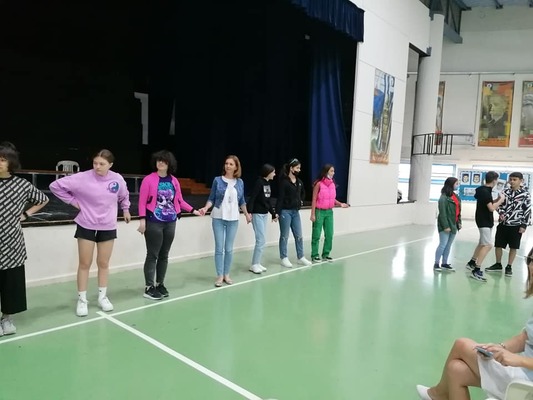
A doua zi a aventurii noastre populare trebuia să fie la fel de perfectă ca și cea anterioară. Am început-o cu sărbătorirea zilei de naștere a coordonatorului cipriot Eleni și a elevei române Amalia Elena. Vizitarea Lefkara pe vreme însorită a fost o experiență destul de plăcută. După un scurt tur prin sat în care am putut admira frumusețea și diversitatea arhitecturii grecești diferite de cele pe care obișnuim să le vedem în țările noastre am ajuns la Centrul de Artizanat Lefkara unde ni s-au prezentat numeroase exemple de broderie și dantele realizate de femeile din localitate. Următoarea oprire pe drum a fost o vizită la Muzeul Etnologic Local de Broderie Tradițională și Argintărie, urmată de alta la biserica Sfânta Cruce, care datează din secolul al XIII-lea. Al doilea sat planificat în acea zi a fost Skarinou Village, locul în care în Ktima Georgiadi și Golden Donkeys Farm am avut șansa să învățăm cum să coacem pâine tradițională „koulouria” și halloumi de casă. Majoritatea participanților s-au bucurat de gustul ambelor produse tradiționale. Acesta este, de asemenea, locul în care se cultivă măslini, dintre care unul este cel mai vechi din Cipru și inclus pe lista patrimoniului cultural UNESCO.
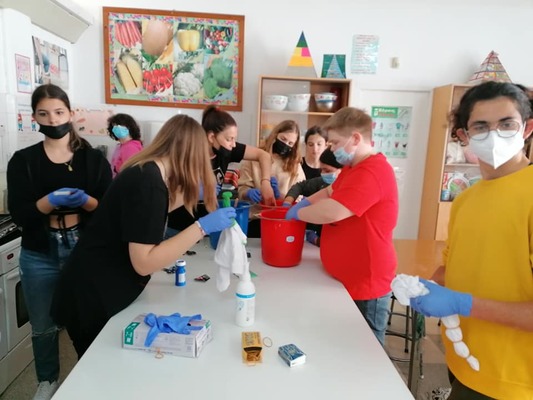
O altă parte a vizitei proiectului a fost un tur la muzeul popular rural cu echipamente vechi folosite în trecut pentru lucrări agricole. La sfârșitul zilei am fost tratați cu specialități locale servite în restaurantul fermei. Pe drumul de întoarcere către Paphos ne-am oprit să ne minunăm de Stânca Afroditei - locul în care s-a născut. A treia zi a început cu o vizită la Castelul Medieval Paphos din portul Kato Paphos. În primul rând, am mers împreună la Situl Arheologic Neo Paphos, fiind un sit de patrimoniu mondial plin de mozaicuri remarcabile grecești antice care prezintă scenele mitologiei grecești. Cu ajutorul unui ghid am învățat multe. În castelul situat în port participanții internaționali au putut vedea expoziția de fotografii cu floră și faună, precum și afișe care ilustrează natura distructivă a unui om pentru mediul oceanic.
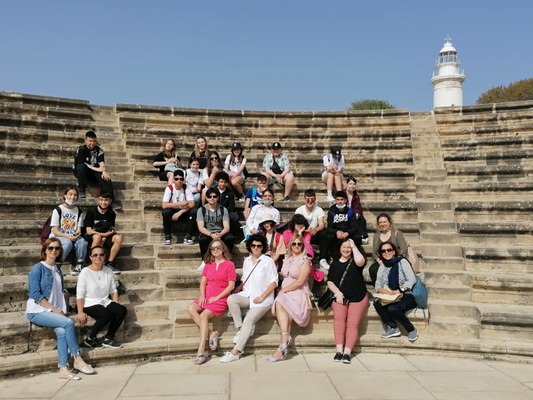
În trecut, castelul făcea parte dintr-o curte și era folosit și ca închisoare. După scurta excursie ne-am îndreptat spre Satul Fyti unde am fost ghidați către muzeul de țesut și artă populară. Am admirat expoziția de piese vestimentare lucrate manual țesute de proprietar. În cadrul atelierului de țesut „Fytiotiko” am cunoscut diferite tehnici și am avut șansa să încercăm să le învățăm. A fost o sarcină foarte plăcută. Elevii de după-amiază împreună cu gazdele lor petrec timpul gătind activ, distrându-se pe plajă sau explorând orașul. A patra zi a aventurii noastre populare a început în Agora (piața). De data aceasta, un ghid ne-a arătat prin orașul vechi și ne-a prezentat istoria și moștenirea culturală a locului. După ce am terminat, gazdele ne-au dus în satul Geroskipou unde am vizitat vechea fabrică de delicii ale Afroditei (Loukoumia), Biserica bizantină Agia Paraskevi și Sanctuarul Afroditei. Lăsând elevii cu gazdele lor și dându-le timp să se pregătească pentru cina de rămas bun, profesorii au avut o întâlnire a coordonatorilor și au lucrat la sarcinile proiectului. Seara toate echipele au petrecut-o împreună distrându-se la cina festivă. A cincea și ultima zi a vizitei noastre a fost foarte provocatoare, dar în același timp plăcută. Elevii internaționali în timp ce au luat parte la atelierul de vopsit cravate și tricouri și-au putut arăta creativitatea și abilitățile artistice. Rezultatele atelierului au fost extraordinare.
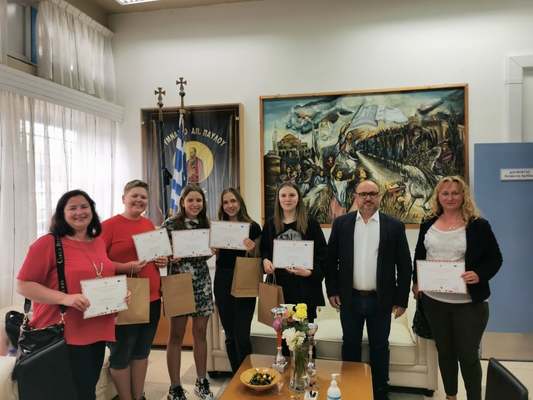
Atelierul a fost apoi urmat de activitatea pe care o așteptam cu nerăbdare încă de la începutul întâlnirii. Grupul cultural „Ieroi Kipoi” îmbrăcat în costume populare ne-a prezentat dansurile tradiționale reprezentative cipriote. După prezentare am fost nerăbdători să ne alăturăm grupului, să participăm la dans pentru a încerca să o facem la fel de perfect ca interpreții gazdă. Ei păreau a fi profesori la fel de buni pentru noi, precum eram noi elevii. În scurta pauză pentru cafea și brunch, am fost tratați cu delicioase specialități cipriote tradiționale, de casă. În timp ce elevii participau la lecții, profesorii lucrau din greu la documente, produse finale și planuri pentru ultimul schimb pe termen scurt din Lituania. Ultima parte a zilei petrecute la școală a fost înmânarea certificatelor de participare le mobilitate, înmânate de către director și coordonatorul gazdă. Profesorii gazdă ne-au recomandat apoi o plimbare de-a lungul zonei de coastă din Kato Paphos. După-amiaza târziu, după cumpărături pentru suveniruri, elevii au avut ocazia să observe și să admire frumoasele apusuri de pe plaja pitorească Lighthouse. Seara a fost petrecută cu toții făcând bagajele și pregătindu-se pentru drumul înapoi spre casă. A fost o săptămână minunată și minunată petrecută împreună cu prietenii noștri ciprioți.
Gabriela Mirela Jugar, Erasmus+ coordinator ”C-tin Noica” High School Sibiu
The Mobility in Lithuania
The first morning of the short-term exchange of groups of pupils began with the meeting of all international participants in the gymnasium. The guests were welcomed with bread and salt and then they had an opportunity to participate in Lithuanian folk dance class. In order to help pupils make new friends they took part in some icebreaking activities. Meanwhile, teachers had the opportunity to look around the gymnasium and learn more about the educational institutions’ goals and directions. The afternoon spent actively in Kaunas Old Town brought pupils a lot of fun while taking part in an orientation competition and learning about the history and architecture of the Old Town. The teachers at the same time visited some Kaunas attractions such as a church, a cathedral and a castle. The day was crowned with the teachers’ trip to the Culinary Heritage House, where the participants not only got acquainted with the traditional Lithuanian cuisine, tasted traditional dishes, but also tried to bake a traditional Lithuanian cake. Tuesday morning started with the trip to Trakai. We visited the 14th century castle on the Island of Galve Lake in Trakai. The next step was educational Kibinai baking programme in a traditional café, where we not only learnt how to make a traditional Karaim dish ourselves which gave us a lot of fun and satisfaction, but also learnt about the culture, customs and traditions of the small nation. Finally, the guests could taste Kibinai with broth and traditional tea. After that, we had the opportunity to admire Uzutrakis manor located in the beautiful landscape reserve. Exploring Dukstai oak educational hiking trail, being the next stop on our way, we took part in an adventurous competition surrounded by the green landscapes of the spring. The winning international team was prized with delicious, traditional Lithuanian branch cake. While participating in the activities, the guests learnt about Lithuanian pagan gods and goddesses. The third day of the exchange was also full of activities, not less interesting than the previous ones. This time we headed for Anyksciai, a town in north-eastern Lithuania where hospitable educators of the historical complex of Seimyniskeliai (Voruta) hill fort presented the program “Findings of Voruta speaking”. We got got acquainted with archaeological findings of Seimyniskeliai mound that traces back centuries and are the most important witnesses of the existence of Voruta Castle, soldiers’ clothing and armament. That was not the only attraction of the place. We could also test the accuracy of our hands by throwing an axe and shooting from a bow which appeared to be more challenging than we could expect. The show of how a catapult works and trying out ancient board games let us move back in time a bit. In the afternoon, they visited Anyksciai Horse Museum, where in the authentic hut of the 20th century they got acquainted with a long way of bread making that spans from sowing rye to a piece of bread. Everyone was given a unique opportunity to shape and bake their own loaf of bread, is a symbol of Lithuanian ethnic culture. At the end of the day, the participants visited the legegndary symbol of Anyksciai town - Puntukas, the second largest boulder in Lithuania. Folk and cultural adventure continues... The day started with the departure to Rumsiskės Folk Museum, one of the largest ethnographic open-air museums in Europe with the highest number of exhibits where the lifestyle and traditions of Lithuanian peasants and townpeople of the second half of the 18th century to the first half of the 20th century of the ethnographic regions of Lithuania, i.e. Dzukija, Aukstaitija, Suvalkija, Zemaitija and Lithuania Minor were presented. We also had the opportunity to visit the centerpiece of the museum, i.e. a town featuring buildings from all over Lithuania typical to different time periods. While the students took part in an adventurous educational competition, the teachers walked around the museum and took part in the educational programme about the folk music “Let's Make Music Together”. The activities were followed by some barbecue time, during which partner countries presented their homework, i.e. two traditional folk games. The time spent in the open air was a great opportunity to enjoy ourselves. The last and final day of the short-term exchange has come... It was the day of evaluation of all the work done and knowledge gained during the entire mobility. Students and teachers participated in Protmusis (Literally “Fightmind” in Lithuanian) and had the opportunity to test their memory and knowledge gained during the week devoted to cultural heritage. Every team deserved to win but the Spanish defeated the others in the mind-battle of “Folklore tells”. The second part was an educational programme “The Friendship of Wool and Soap”. Participants learnt traditional wool felting technique and made soap. Meanwhile, the teachers discussed the activities of the week, signed project related documents, and presented the final products of the project. In the evening, a certification ceremony and farewell evening took place, which was accompanied by some mixed feelings. On the one hand, everyone felt sad since it was the very final meeting of the project; on the other hand, we all were overwhelmed by the multicultural experience we had. The show prepared by the hosts took our breaths away. Friendship of nations made the world small and open and hopefully the relationship between all of us will last for a long time.
Mariola Podolska-Maculewicz, Gimnazjum Nr 2 z Oddziałami integracyjnymi im. Michała Kajki, project coordinator
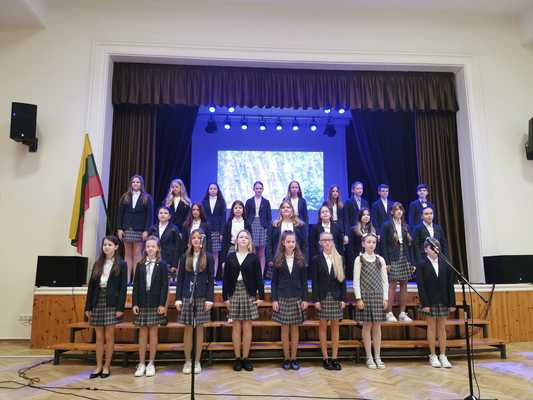
https://www.facebook.com/erkan.demirci.5074/videos/528846248720889
Mobilitatea în Lituania
Prima dimineață a schimbului pe termen scurt de grupuri de elevi a început cu întâlnirea tuturor participanților internaționali la gimnaziu. Oaspeții au fost întâmpinați cu pâine și sare și apoi au avut ocazia să participe la cursul de dans popular lituanian. Pentru a-i ajuta pe elevi să-și facă prieteni noi, aceștia au participat la câteva activități de spargere a gheții. Între timp, profesorii au avut ocazia să se uite în jurul gimnaziului și să afle mai multe despre obiectivele și direcțiile instituțiilor de învățământ. După-amiaza petrecută activ în orașul vechi din Kaunas a adus elevilor o mulțime de distracție în timp ce participau la un concurs de orientare și învățau despre istoria și arhitectura orașului vechi. În același timp, profesorii au vizitat câteva atracții din Kaunas, cum ar fi o biserică, o catedrală și un castel. Ziua a fost încununată cu excursia profesorilor la Casa Patrimoniului Culinar, unde participanții nu numai că s-au familiarizat cu bucătăria tradițională lituaniană, au gustat mâncăruri tradiționale, dar au încercat și să coace o prăjitură tradițională lituaniană. Marți dimineața a început cu excursia la Trakai. Am vizitat castelul din secolul al XIV-lea de pe Insula Lacului Galve din Trakai. Următorul pas a fost programul educațional de coacere Kibinai într-o cafenea tradițională, unde nu numai că am învățat cum să facem singuri un fel de mâncare tradițională Karaim, ceea ce ne-a oferit multă distracție și satisfacție, dar am învățat și despre cultura, obiceiurile și tradițiile micuței naţiuni. În cele din urmă, invitații au putut gusta Kibinai cu bulion și ceai tradițional. După aceea, am avut ocazia să admirăm conacul Uzutrakis situat în frumoasa rezervație peisagistică. Explorând traseul educațional de drumeții din stejarul Dukstai, fiind următoarea oprire pe drum, am participat la o competiție plină de aventuri înconjurați de peisajele verzi ale primăverii. Echipa internațională câștigătoare a fost premiată cu un tort tradițional lituanian delicios. În timpul participării la activități, oaspeții au aflat despre zeii și zeițele păgâne lituaniene. A treia zi a schimbului a fost și ea plină de activități, nu mai puțin interesante decât cele precedente. De data aceasta ne-am îndreptat către Anyksciai, un oraș din nord-estul Lituaniei, unde educatorii ospitalieri din complexul istoric al fortului de deal Seimyniskeliai (Voruta) au prezentat programul „Descoperirile vorbitorului Voruta”. Am făcut cunoștință cu descoperirile arheologice ale movilei Seimyniskeliai, care are secole în urmă și sunt cei mai importanți martori ai existenței Castelului Voruța, îmbrăcămintea și armamentul soldaților. Nu era singura atracție a locului. De asemenea, ne-am putut testa agilitatea mâinilor aruncând un topor și trăgând cu un arc care părea a fi mai provocator decât ne-am putut aștepta. Spectacolul despre cum funcționează o catapultă și încercarea de jocuri de societate antice ne-au permis să ne întoarcem puțin în timp. După-amiaza, am vizitat Muzeul Calului Anyksciai, unde în coliba autentică a secolului XX am făcut cunoștință cu o lungă metodă de fabricare a pâinii, care se întinde de la semănat de secară la o bucată de pâine. Toată lumea a primit o oportunitate unică de a-și modela și coace propria pâine, aceasta fiind un simbol al culturii etnice lituaniene. La sfârșitul zilei, participanții au vizitat simbolul legendar al orașului Anyksciai - Puntukas, al doilea ca mărime bolovan din Lituania. Aventura populară și culturală continuă. Ziua a început cu plecarea către Muzeul Popular din Rumsiskės, unul dintre cele mai mari muzee etnografice în aer liber din Europa, cu cel mai mare număr de exponate, unde se află stilul de viață și tradițiile țăranilor și orășenilor lituanieni din a doua jumătate a secolului al XVIII-lea până în prima jumătate a secolului al XX-lea au fost prezentate regiunile etnografice ale Lituaniei, adică Dzukija, Aukstaitija, Suvalkija, Zemaitija și Lituania Mică. De asemenea, am avut ocazia să vizităm piesa centrală a muzeului, adică un oraș cu clădiri din toată Lituania, tipice pentru diferite perioade de timp. În timp ce elevii au participat la o competiție educațională aventuroasă, profesorii s-au plimbat prin muzeu și au participat la programul educațional despre muzica populară „Să facem muzică împreună”. Activitățile au fost urmate de un grătar, timp în care țările partenere și-au prezentat temele, adică două jocuri populare tradiționale. Timpul petrecut în aer liber a fost o oportunitate grozavă de a ne distra. A venit apoi și ultima zi a schimbului pe termen scurt. A fost ziua evaluării întregii munci depuse și a cunoștințelor acumulate pe parcursul întregii mobilități. Elevii și profesorii au participat la Protmusis (Literal „Fightmind” în lituaniană) și au avut ocazia să-și testeze memoria și cunoștințele acumulate în săptămâna dedicată patrimoniului cultural. Fiecare echipă a meritat să câștige, dar spaniolii i-au învins pe ceilalți în bătălia mentală de la „Folclore tells”. A doua parte a fost un program educațional „Prietenia lânii și a săpunului”. Participanții au învățat tehnica tradițională de împâslire din lână și au făcut săpun. Între timp, profesorii au discutat despre activitățile săptămânii, au semnat documente legate de proiect și au prezentat produsele finale ale proiectului. Seara a avut loc o ceremonie de certificare și o seară de rămas bun, care a fost însoțită de unele sentimente amestecate. Pe de o parte, toată lumea s-a simțit tristă deoarece era chiar ultima întâlnire a proiectului; pe de altă parte, toți am fost copleșiți de experiența multiculturală pe care am avut-o. Spectacolul pregătit de gazde ne-a tăiat răsuflarea. Prietenia națiunilor a făcut lumea mică și deschisă și sperăm că relația dintre noi toți va dura mult timp.
Gabriela Mirela Jugar, coordonator, Liceul „C-tin Noica” Sibiu
https://www.facebook.com/100002716524140/videos/pcb.1704892399859287/686449139279570
